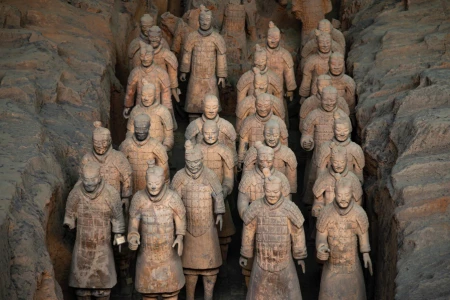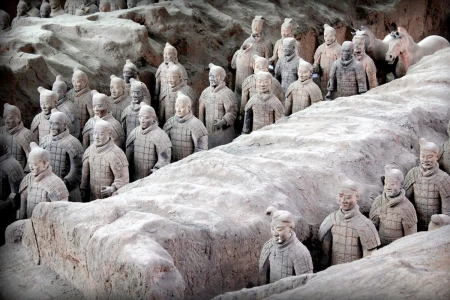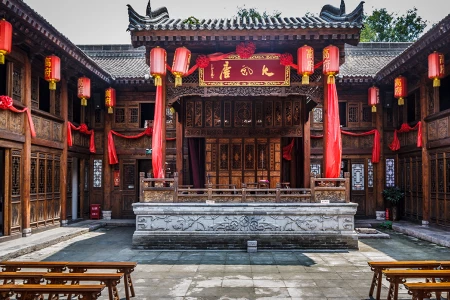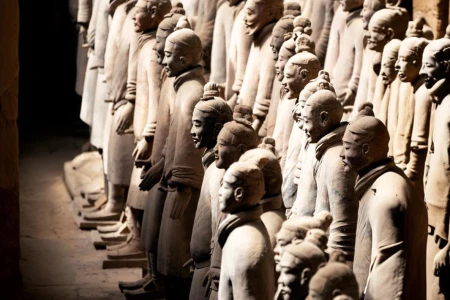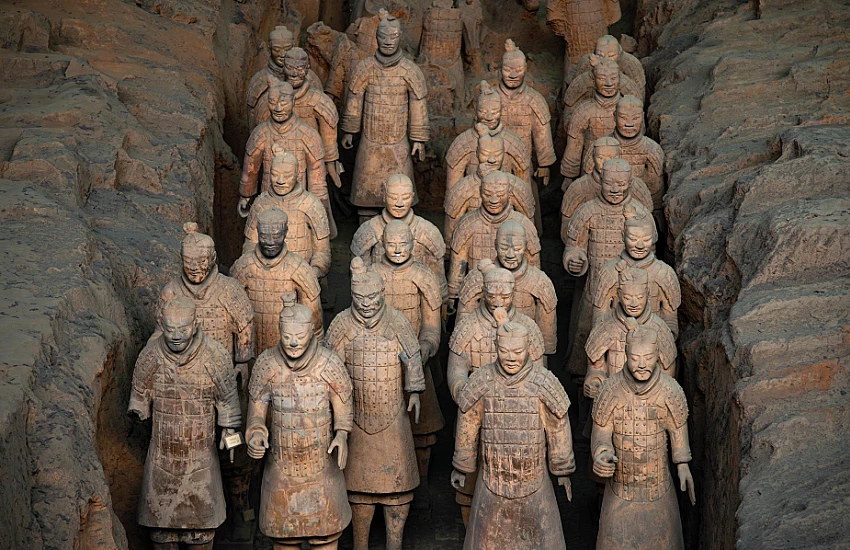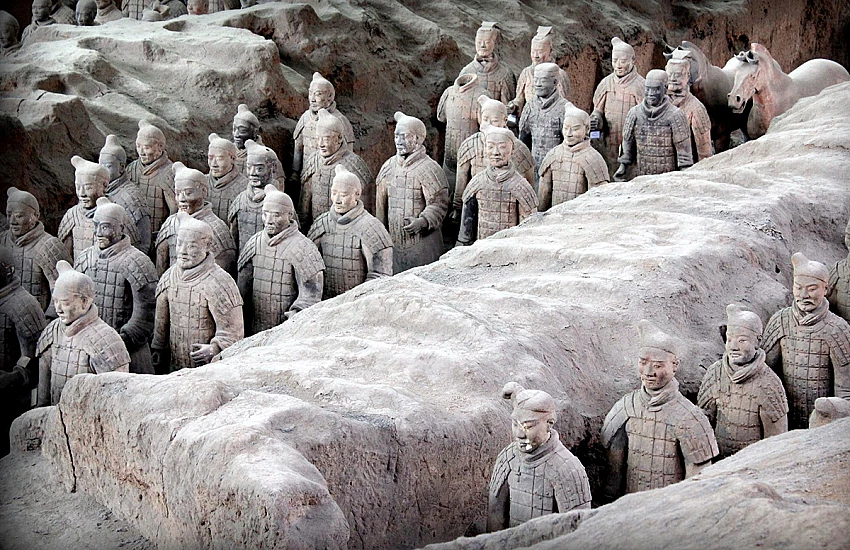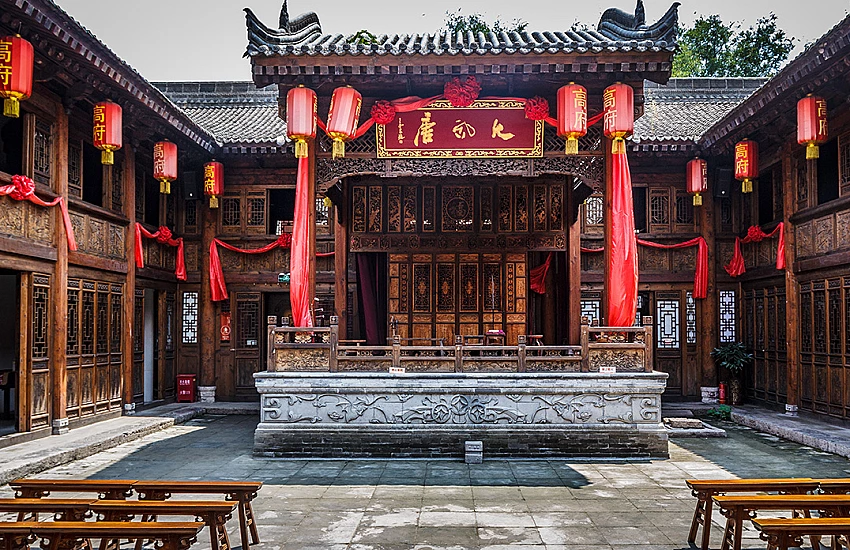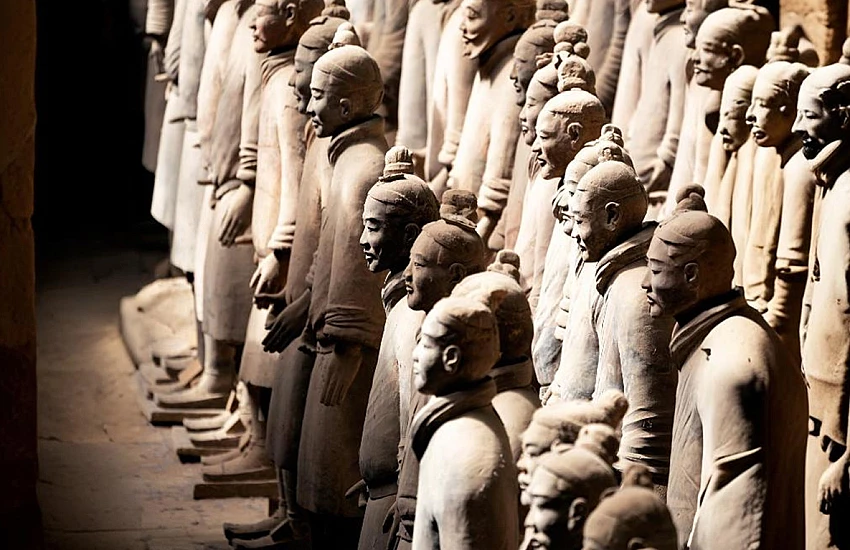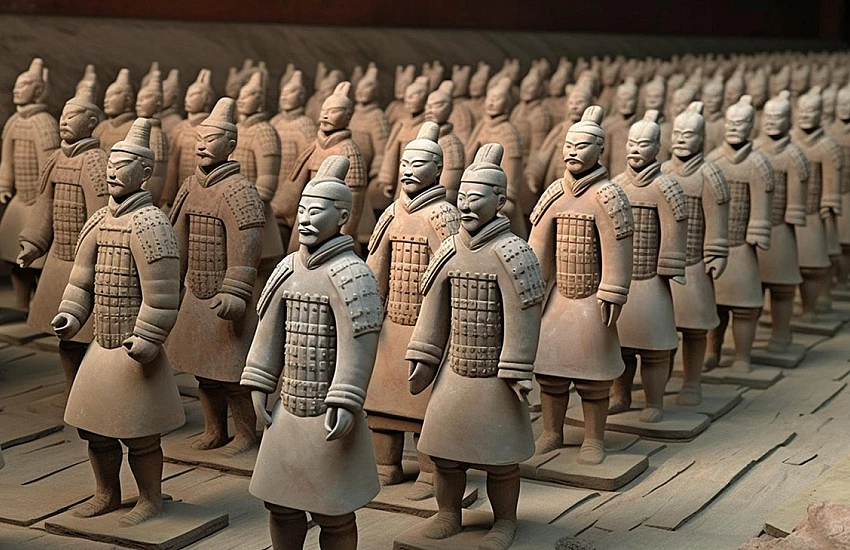
Table des matières
The Terracotta Army, one of the most significant archaeological discoveries of the 20th century, offers a fascinating glimpse into ancient Chinese history and the enigmatic reign of China's first emperor, Qin Shi Huang. Unearthed in 1974 by local farmers near Xi'an in Shaanxi Province, this vast assembly of life-sized terracotta soldiers, chariots, and horses has captivated historians, archaeologists, and tourists alike.
The discovery not only revealed the grandeur and ambition of Emperor Qin Shi Huang but also provided valuable insights into the artistic and technological advancements of ancient China.
Emperor Qin Shi Huang ascended to power in 221 BCE after successfully unifying various warring states under a central authority. His reign marked the beginning of imperial China and laid the foundations for a centralized bureaucratic government that lasted for over two millennia. To ensure his legacy endured beyond his mortal existence, Qin Shi Huang embarked on an ambitious project: constructing an enormous mausoleum guarded by an army built from clay—a testament to his power and vision.
The Terracotta Army was designed to accompany Emperor Qin Shi Huang in his afterlife, providing protection and service just as a real army would during his reign. Buried approximately 1.5 kilometers east of the emperor's mausoleum at Mount Li, these meticulously crafted figures were arranged in precise military formations within three massive pits. Each warrior was intricately detailed with unique facial features, hairstyles, armor styles, and postures—reflecting their rank and role within this grand celestial battalion.
The craftsmanship displayed in creating these figures is nothing short of extraordinary. Artisans employed sophisticated techniques to mold each soldier from local clay before firing them at high temperatures to achieve durability. The statues were then vividly painted using natural pigments; although most colors have faded over time due to exposure to air after excavation.
Beyond their artistic merit, these terracotta warriors provide invaluable information about military practices during Qin Dynasty China. The arrangement of soldiers suggests a well-organized command structure with distinct hierarchies—from foot soldiers armed with bronze weapons like swords and spears to higher-ranking officers astride chariots or mounted on horseback.
As you journey through this remarkable archaeological site today—now part of a UNESCO World Heritage list—you are transported back over two thousand years into an era defined by monumental achievements both on battlefields across ancient China as well as within realms envisioned for eternity itself by its visionary leader: Emperor Qin Shi Huangdi—the man whose legacy continues unfolding through terracotta sentinels frozen eternally in time beneath Xi’an’s soil.
Historical Context: The Life And Reign Of Emperor Qin Shi Huang
To fully appreciate the significance of the Terracotta Army, one must delve into the life and reign of its visionary creator, Emperor Qin Shi Huang. Born in 259 BCE as Ying Zheng, he ascended to the throne at the tender age of 13 after his father, King Zhuangxiang of Qin, passed away. The Kingdom of Qin was one among several warring states vying for dominance over ancient China.
Overcoming internal strife and external threats, Ying Zheng grew to become a formidable ruler.
By 221 BCE, Ying Zheng achieved what had been unthinkable for centuries: he unified China under a centralized imperial government after defeating rival states. Proclaiming himself Qin Shi Huangdi—meaning "First Emperor of Qin"—he initiated sweeping reforms that would lay the groundwork for a unified Chinese culture and governance structure.
Under his rule, China saw unprecedented centralization and standardization efforts. He instituted uniform weights and measures, standardized currency and writing systems, and even synchronized axle lengths for carts to facilitate smoother travel across newly built roads. His legalist policies were often harsh but immensely effective in consolidating power.
Qin Shi Huang’s reign was also marked by monumental construction projects that showcased his ambition but also drained human resources extensively. The Great Wall's early segments were connected during his time to fend off northern invaders; an enduring symbol of China's engineering prowess and defensive strategy.
However, perhaps no project reflects both his grandeur and obsession with immortality more than his own mausoleum near Xi'an—a sprawling necropolis guarded by an army crafted from terracotta clay. This army was intended to protect him in the afterlife as fervently as his real soldiers had done during life.
Ironically, despite all efforts toward eternal life—including quests for elixirs that might grant immortality—Qin Shi Huang died in 210 BCE at the age of 49 during one such journey. His death plunged China into chaos once more as power struggles ensued; however, his legacy endured through subsequent dynasties that built upon the foundations he laid.
The Terracotta Army stands today not only as a testament to Emperor Qin Shi Huang's military might but also as an enduring symbol of ancient China's complex history—a blend of extraordinary achievement and relentless ambition driven by one man's vision for unity and eternal dominance.
Archaeological Marvel: The Discovery And Excavation Of The Site
The archaeological marvel of the Terracotta Army's discovery and excavation is a tale that intertwines serendipity with meticulous scholarship. In March 1974, a group of farmers in Lintong District, near Xi'an in Shaanxi Province, stumbled upon fragments of what would become one of the most significant archaeological finds of the 20th century. As they dug a well to alleviate water scarcity, they unearthed shards of terracotta figures and bronze weapons, sparking the interest of local authorities and archaeologists.
What followed was an extensive exploration that revealed an underground army created over two millennia ago to accompany China's first Emperor, Qin Shi Huang, into the afterlife. The site spans approximately 22 square miles and comprises three main pits filled with thousands of life-sized warriors, chariots, horses, and even non-military figures such as acrobats and musicians. Each figure is unique in its facial features and expressions, reflecting a high degree of craftsmanship.
Excavation began under challenging conditions; researchers had to carefully navigate through fragile relics buried beneath layers of earth while contending with shifts in soil composition that threatened to collapse parts of the site. Chinese archaeologists employed advanced techniques such as ground-penetrating radar and meticulous manual excavation methods to preserve these ancient treasures.
The uncovering continued over decades, revealing not just military might but also insights into the technological prowess and cultural sophistication during Qin Shi Huang's reign (221-206 BCE). The richly detailed artifacts offer glimpses into ancient Chinese metallurgy, artistry, and organizational skills.
Today’s ongoing excavations still yield new revelations about this awe-inspiring necropolis. The Terracotta Army stands as both a symbol of human ingenuity and a testament to our enduring quest to understand history's enigmatic chapters.
Secrets Of The Craftsmen: Techniques And Mysteries Of Construction
The Terracotta Army of Xi'an, a mesmerizing testament to ancient Chinese craftsmanship, conceals within its ranks a trove of secrets regarding the techniques and mysteries employed by the artisans who brought it to life. These craftsmen, operating under the directive of China's first emperor, Qin Shi Huang, harnessed both advanced methods and enigmatic practices to create an enduring legacy.
One of the most intriguing aspects of their work lies in the construction techniques used to produce life-sized statues with such realism and detail. Each figure was meticulously crafted from local clay, mixed with other materials to enhance durability. The artisans employed a modular approach: different parts of the figures—heads, torsos, arms, and legs—were sculpted separately and then assembled. This method not only facilitated mass production but also allowed for individual customization; each warrior bears unique facial features and expressions.
The firing process is another area shrouded in mystery. The figures were fired at relatively low temperatures in large kilns that could accommodate their size. Remarkably, despite these conditions, many warriors have survived nearly intact for over two millennia. This longevity suggests that the craftsmen had an intimate understanding of kiln dynamics and temperature control.
Equally fascinating is the coloration technique used on these figures. Originally adorned with vibrant pigments derived from natural minerals like cinnabar (red) and malachite (green), these colors were applied after firing using a lacquer base made from tree sap. However, exposure to air caused rapid deterioration upon excavation—a testament to both the ingenuity and ephemeral nature of ancient artistry.
Lastly, one cannot overlook the logistical marvels behind this endeavor. Organizing thousands of laborers while maintaining quality control over such intricate work required sophisticated management systems—a precursor to modern assembly lines.
In essence, unraveling these secrets not only illuminates ancient Chinese technological prowess but also underscores a profound cultural legacy that continues to captivate scholars and visitors alike.
Decoding The Warriors: Symbols, Ranks, And Artifacts
In the heart of Xi'an, the silent rows of the Terracotta Army stand as a testament to ancient Chinese craftsmanship and military organization. However, beyond their stoic expressions and lifelike appearances, these clay soldiers hold a trove of encoded messages about the society that created them. Decoding these warriors reveals insights into symbols, ranks, and artifacts that are key to understanding this ancient civilization.
Each terracotta figure is meticulously crafted with unique features, yet it is their collective arrangement and individual details that reveal a sophisticated system of military hierarchy. The army is organized in precise formations, mirroring the strict regimentation of an actual battlefield. High-ranking officers can be identified by their elaborate armor and headgear. For instance, generals wear distinctive double-layered robes adorned with intricate designs symbolizing their elevated status.
These visual markers were not mere artistic flourishes but practical identifiers in both life and death.
Symbols abound within this clay legion—whether etched into armor or subtly integrated into weaponry—each carrying significant meaning. Dragons and phoenixes frequently appear on higher-ranking soldiers’ uniforms, emblematic of power and divine protection in Chinese culture. Meanwhile, geometric patterns on shields or chest plates often denote specific units or battalions within the larger army structure.
Artifacts accompanying the warriors further deepen our understanding of Qin Dynasty martial practices. The discovery of real bronze weapons among the terracotta figures was a revelation; many swords remained sharp after more than two millennia due to advanced metallurgy techniques involving chromium oxide plating—a process not rediscovered until modern times. Chariots found alongside infantrymen highlight not only tactical diversity but also technological sophistication in transport and combat strategies.
Moreover, inscriptions on some weapons provide clues about manufacturing details and quality control processes from that era. Marks indicating workshops or individual craftsmen suggest an organized production line dedicated to equipping this vast underground force.
The Terracotta Army stands as more than just funerary art; it is an encyclopedia written in clay about ancient China's military might and societal structure. Through careful analysis of symbols, ranks, and artifacts embedded within these silent soldiers, we gain invaluable insights into a civilization whose ingenuity continues to awe us today. This decoding process transforms what appears at first glance as mere statuary into a vibrant narrative detailing one of history's most enigmatic empires.






